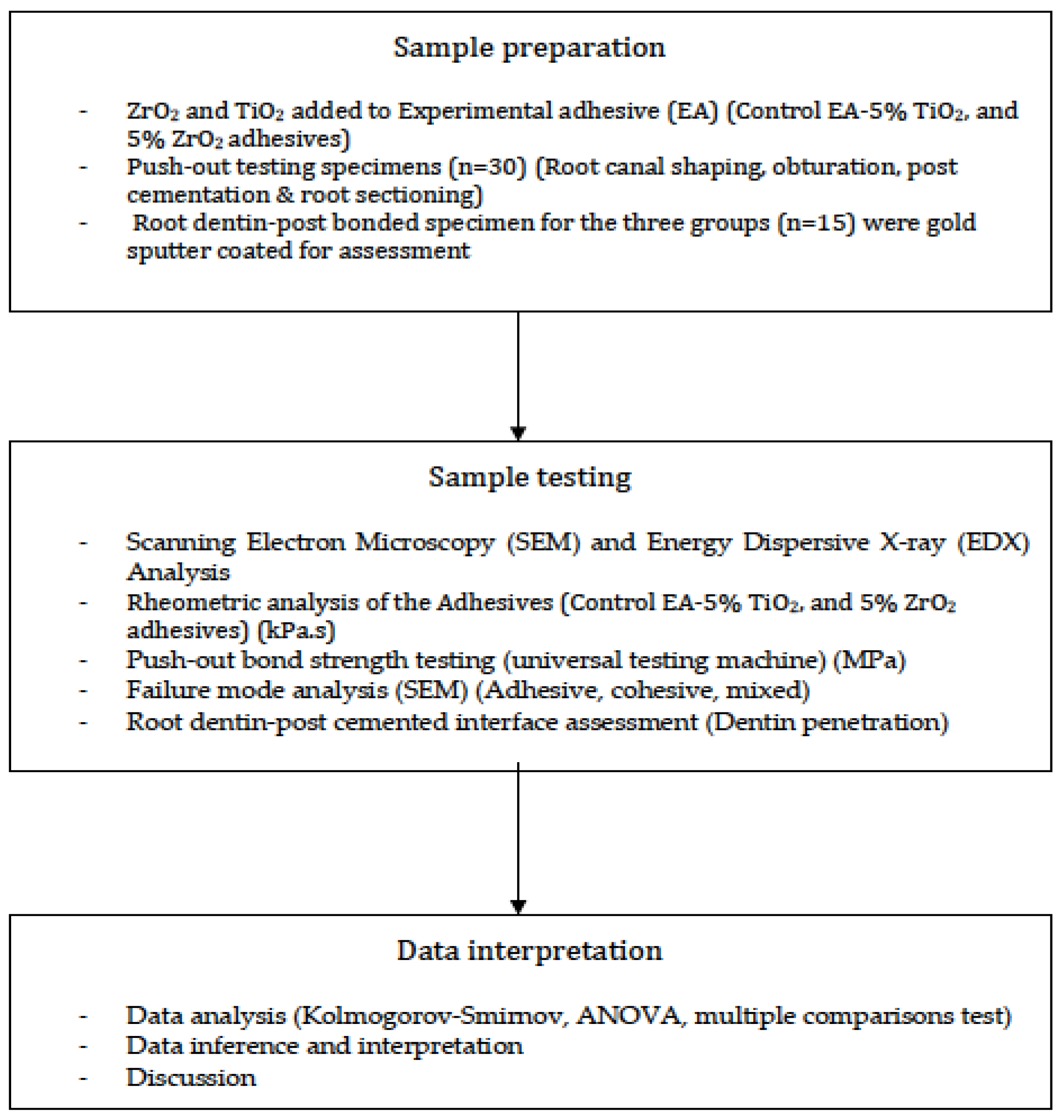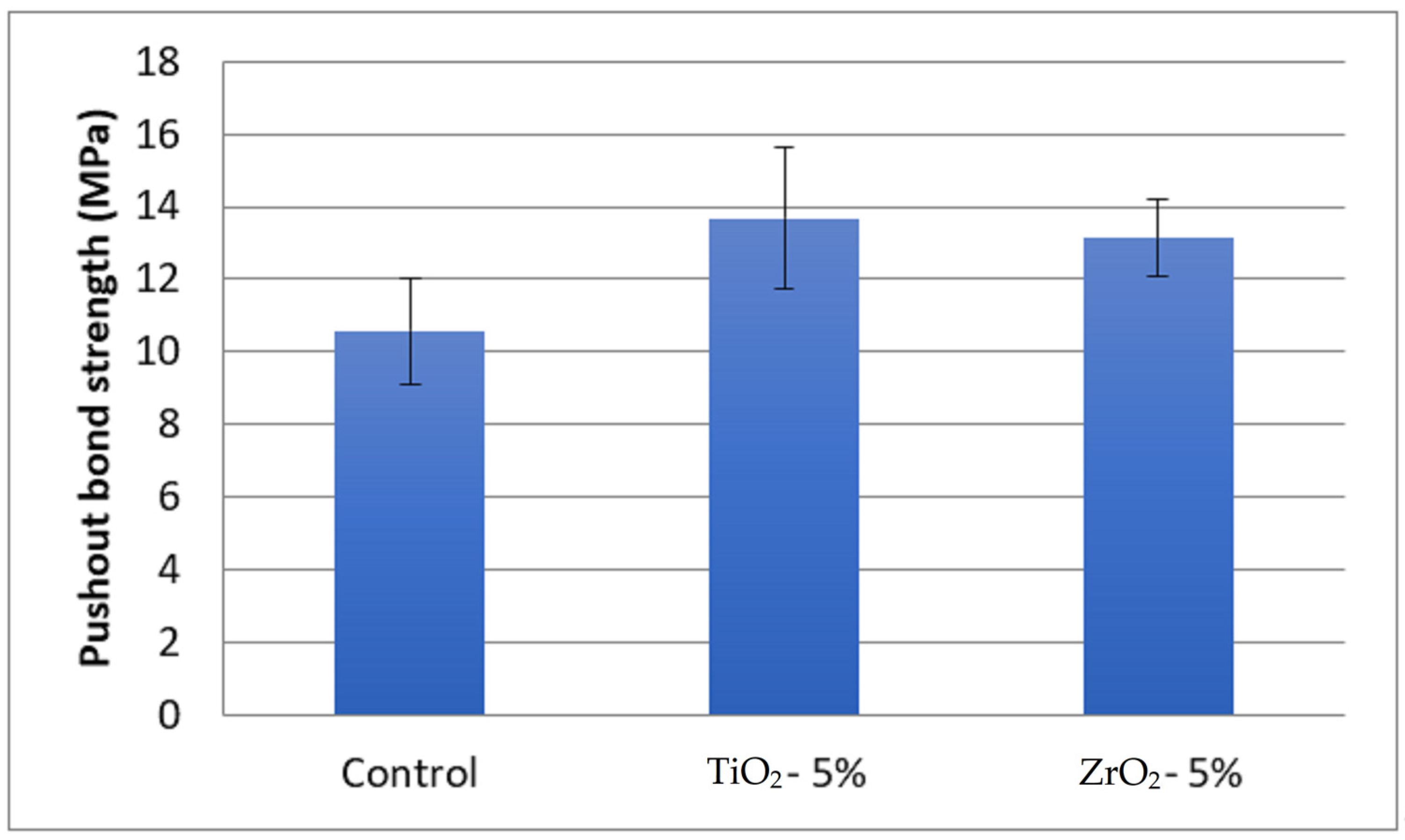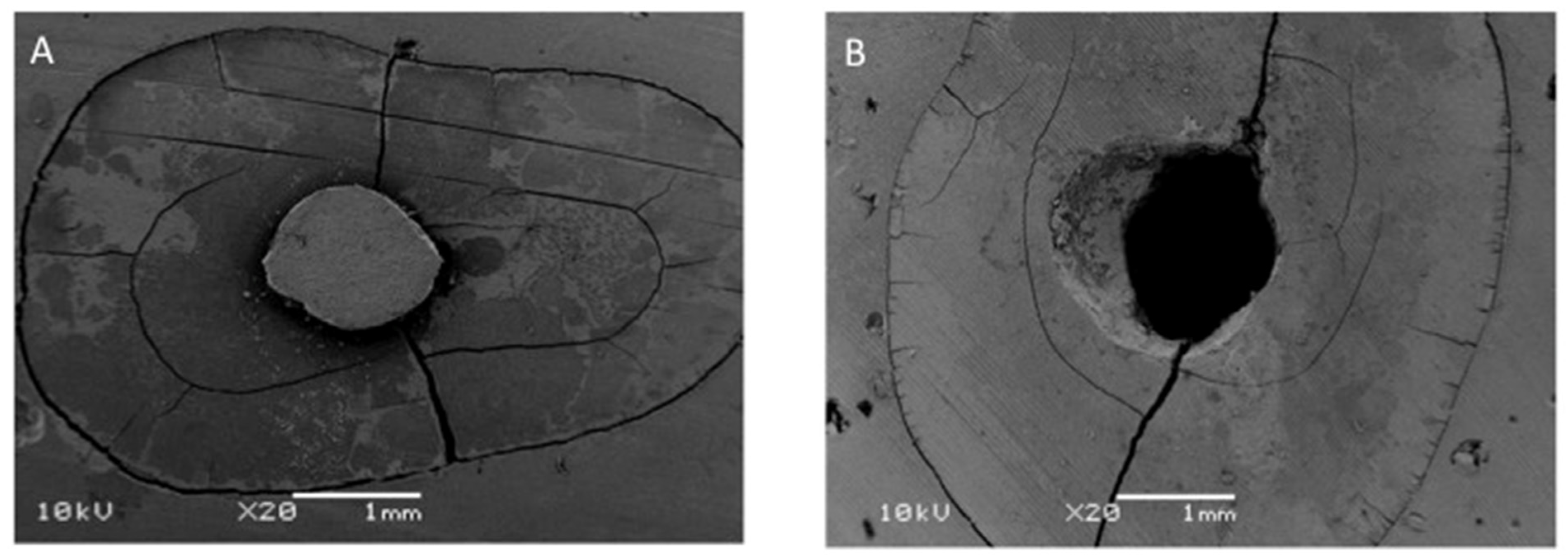Strength of Fiber Posts with Experimental TiO2 and ZrO2 Particle Bonding—An SEM, EDX, Rheometric and Push-Out Strength Study
Abstract
:1. Introduction
2. Materials and Methods
2.1. Preparation of the ZrO2 and TiO2 Added Experimental Adhesive (EA)
2.2. Scanning Electron Microscopy (SEM) and Energy-Dispersive X-ray (EDX) Analysis
2.3. Rheometric Analysis of the Adhesives
2.4. Specimen Preparation for Push-Out Bond Strength Assessment
2.5. Push-Out Bond Strength Assessments
2.6. SEM Observation of Adhesive-Dentin Interface
2.7. Statistical Analysis
3. Results
3.1. Outcomes of the Characterization of the Filler Particles
3.2. Outcomes of the Assessment of the Rheological Properties
3.3. Outcomes of Push-Out Bond Strength and Failure Mode Analysis
3.4. Qualitative Assessment of Resin-Dentin Interface
4. Discussion
5. Conclusions
Author Contributions
Funding
Institutional Review Board Statement
Informed Consent Statement
Data Availability Statement
Acknowledgments
Conflicts of Interest
References
- Qualtrough, A.A.J.; Mannocci, F. Tooth-colored post systems: A review. Oper. Dent. 2003, 28, 86–91. [Google Scholar] [PubMed]
- Bonfante, E.A.; Pegoraro, L.F.; de Góes, M.F.; Carvalho, R.M. SEM observation of the bond integrity of fiber-reinforced composite posts cemented into root canals. Dent. Mater. Off. Publ. Acad. Dent. Mater. 2008, 24, 483–491. [Google Scholar] [CrossRef] [PubMed]
- Butz, F.; Lennon, A.M.; Heydecke, G.; Strub, J.R. Survival rate and fracture strength of endodontically treated maxillary incisors with moderate defects restored with different post-and-core systems: An in vitro study. Int. J. Prosthodont. 2001, 14, 58–64. [Google Scholar]
- De Miranda Coelho, C.S.; Biffi, J.C.G.; da Silvagr, G.R.; Abrahão, A.; Campos, R.E.; Soares, C.J. Finite element analysis of weakened roots restored with composite resin and posts. Dent. Mater. J. 2009, 28, 671–678. [Google Scholar] [CrossRef] [PubMed]
- AlAali, K.A.; AlHelal, A.; Almahri, J.R.; Albakri, A.A.; Albani, R.M.; Alhaizan, Y.A.; Alhamdan, M.M.; Alaql, N.A.; Binhasan, M.; Alhamdan, E.M.; et al. Influence of conventional polymer, hybrid polymer and zinc phosphate luting agents on the bond strength of customized zirconia post in premolars—An in-vitro evaluation. Polymers 2022, 14, 758. [Google Scholar] [CrossRef] [PubMed]
- Sofan, E.; Sofan, A.; Palaia, G.; Tenore, G.; Romeo, U.; Migliau, G. Classification review of dental adhesive systems: From the IV generation to the universal type. Ann. Stomatol. 2017, 8, 1–17. [Google Scholar]
- Zhao, Z.W.Q.; Zhao, J.; Zhao, B.; Ma, Z.; Zhang, C. Adhesion in teeth. Front. Mater. 2021, 7, 615225. [Google Scholar] [CrossRef]
- Ferracane, J.L. Models of caries formation around dental composite restorations. J. Dent. Res. 2017, 96, 364–371. [Google Scholar] [CrossRef]
- Iliev, G.; Hardan, L.; Kassis, C.; Bourgi, R.; Cuevas-Suarez, C.E.; Lukomska-Szymanska, M.; Mancino, D.; Haikel, Y.; Kharouf, N. Shelf life and storage conditions of universal adhesives: A literature review. Polymers 2021, 13, 2708. [Google Scholar] [CrossRef]
- Farooq, I.; Ali, S.; Al-Saleh, S.; AlHamdan, E.M.; AlRefeai, M.H.; Abduljabbar, T.; Vohra, F. Synergistic effect of bioactive inorganic fillers in enhancing properties of dentin adhesives—A review. Polymers 2021, 13, 2169. [Google Scholar] [CrossRef]
- Alhenaki, A.M.; Attar, E.A.; Alshahrani, A.; Farooq, I.; Vohra, F.; Abduljabbar, T. Dentin bond integrity of filled and unfilled resin adhesive enhanced with silica particles—An SEM, EDX, micro-Raman, FTIR and micro-tensile bond strength study. Polymers 2021, 13, 1093. [Google Scholar] [CrossRef] [PubMed]
- Almutairi, B.; Kattan, H.F.; BinMahfooz, A.M.; Qutub, O.A.; Basunbul, G.; ArRejaie, A.S.; Farooq, I.; Vohra, F.; Abduljabbar, T. Synergistic effect of graphene oxide/calcium phosphate nanofiller in a dentin adhesive on its dentin bond integrity and degree of conversion. A scanning electron microscopy, energy dispersive X-ray spectroscopy, Fourier transform infrared, micro-Raman, and bond strength study. Microsc. Res. Tech. 2021, 84, 2082–2094. [Google Scholar] [PubMed]
- Al-Saleh, S.; Alateeq, A.; Alshaya, A.H.; Al-Qahtani, A.S.; Tulbah, H.I.; Binhasan, M.; Shabib, S.; Farooq, I.; Vohra, F.; Abduljabbar, T. Influence of TiO2 and ZrO2 particles on adhesive bond strength and viscosity of dentin polymer. A physical and chemical evaluation. Polymers 2021, 13, 3794. [Google Scholar] [CrossRef] [PubMed]
- Madfa, A.A.; Al-Sanabani, F.A.; Al-Quadami, N.H.; Al-Sanabani, J.S.; Amran, A.G. Use of zirconia in dentistry: An overview. Open Biomat. J. 2014, 5, 1–9. [Google Scholar] [CrossRef]
- Grech, J.A.E. Zirconia in dental prosthetics: A literature review. J. Mater. Res. Technol. 2019, 8, 4956–4964. [Google Scholar] [CrossRef]
- Apratim, A.; Eachempati, P.; Krishnappa Salian, K.K.; Singh, V.; Chhabra, S.; Shah, S. Zirconia in dental implantology: A review. J. Int. Soc. Prev. Community Dent. 2015, 5, 147–156. [Google Scholar] [CrossRef]
- Halder, S.; Ahemad, S.; Das, S.; Wang, J. Epoxy/glass fiber laminated composites integrated with amino functionalized ZrO2 for advanced structural applications. ACS Appl. Mater. Interfaces 2016, 8, 1695–1706. [Google Scholar] [CrossRef]
- Lohbauer, U.; Wagner, A.; Belli, R.; Stoetzel, C.; Hilpert, A.; Kurland, H.D.; Grabow, J.; Muller, F.A. Zirconia particles prepared by laser vaporization as fillers for dental adhesives. Acta Biomater. 2010, 6, 4539–4546. [Google Scholar] [CrossRef]
- Cionca, N.; Hashim, D.; Mombelli, A. Zirconia dental implants: Where are we now, and where are we heading? Periodontol. 2000 2017, 73, 241–258. [Google Scholar] [CrossRef]
- Musial, J.; Krakowiak, R.; Mlynarczyk, D.T.; Goslinski, T.; Stanisz, B.J. Titanium dioxide particles in food and personal care products-what dowe know about their safety? Nanomaterials 2020, 10, 1110. [Google Scholar] [CrossRef]
- Sandu, A.V.; Baltatu, M.S.; Nabialek, M.; Savin, A.; Vizureanu, P. Characterization and mechanical proprieties of new TiMo alloys used for medical applications. Materials 2019, 12, 2973. [Google Scholar] [CrossRef] [PubMed]
- Spataru, M.C.; Butnaru, M.; Sandu, A.V.; Vulpe, V.; Vlad, M.D.; Baltatu, M.S.; Geanta, V.; Voiculescu, I.; Vizureanu, P.; Solcan, C. In-depth assessment of new Ti-based biocompatible materials. Mater. Chem. Phys. 2021, 258, 123959. [Google Scholar] [CrossRef]
- Besinis, A.; De Peralta, T.; Handy, R.D. The antibacterial effects of silver, titanium dioxide and silica dioxide particles compared to the dental disinfectant chlorhexidine on Streptococcus mutans using a suite of bioassays. Nanotoxicology 2014, 8, 1–16. [Google Scholar] [CrossRef] [PubMed]
- Jowkar, Z.; Hamidi, S.A.; Shafiei, F.; Ghahramani, Y. The effect of silver, zinc oxide, and titanium dioxide particles used as final irrigation solutions on the fracture resistance of root-filled teeth. Clin. Cosmet. Investig. Dent. 2020, 12, 141–148. [Google Scholar] [CrossRef] [PubMed]
- Jafari, S.; Mahyad, B.; Hashemzadeh, H.; Janfaza, S.; Gholikhani, T.; Tayebi, L. Biomedical Applications of TiO2 Nanostructures: Recent Advances. Int. J. Nanomed. 2020, 15, 3447–3470. [Google Scholar] [CrossRef]
- Esteban Florez, F.L.; Kraemer, H.; Hiers, R.D.; Sacramento, C.M.; Rondinone, A.J.; Silverio, K.G.; Khajotia, S.S. Sorption, solubility and cytotoxicity of novel antibacterial nanofilled dental adhesive resins. Sci. Rep. 2020, 10, 13503. [Google Scholar] [CrossRef]
- Ramos-Tonello, C.M.; Lisboa-Filho, P.N.; Arruda, L.B.; Tokuhara, C.K.; Oliveira, R.C.; Furuse, A.Y.; Rubo, J.H.; Borges, A.F.S. Titanium dioxide nanotubes addition to self-adhesive resin cement: Effect on physical and biological properties. Dent. Mater. 2017, 33, 866–875. [Google Scholar] [CrossRef]
- Chu, C.Y.; Kuo, T.C.; Chang, S.F.; Shyu, Y.C.; Lin, C.P. Comparison of the microstructure of crown and root dentin by a scanning electron microscopic study. J. Dent. Sci. 2010, 5, 14–20. [Google Scholar] [CrossRef]
- AlFawaz, Y.F.; Almutairi, B.; Kattan, H.F.; Zafar, M.S.; Farooq, I.; Naseem, M.; Vohra, F.; Abduljabbar, T. Dentin bond integrity of hydroxyapatite containing resin adhesive enhanced with graphene oxide nano-particles—An SEM, EDX, micro-Raman, and microtensile bond strength study. Polymers 2020, 12, 2978. [Google Scholar] [CrossRef]
- Al-Hamdan, R.S.; Almutairi, B.; Kattan, H.F.; Alsuwailem, N.A.; Farooq, I.; Vohra, F.; Abduljabbar, T. Influence of hydroxyapatite nanospheres in dentin adhesive on the dentin bond integrity and degree of conversion: A scanning electron microscopy (SEM), Raman, fourier transform-infrared (FTIR), and microtensile study. Polymers 2020, 12, 2948. [Google Scholar] [CrossRef]
- Collares, F.M.; Portella, F.F.; Rodrigues, S.B.; Celeste, R.K.; Leitune, V.C.B.; Samuel, S.M.W. The influence of methodological variables on the push-out resistance to dislodgement of root filling materials: A meta-regression analysis. Int. Endod. J. 2016, 49, 836–849. [Google Scholar] [CrossRef] [PubMed]
- Ureyen Kaya, B.; Kececi, A.D.; Orhan, H.; Belli, S. Micropush-out bond strengths of gutta-percha versus thermoplastic synthetic polymer-based systems—An ex vivo study. Int. Endod. J. 2008, 41, 211–218. [Google Scholar] [CrossRef] [PubMed]
- De-Deus, G.; Brandao, M.C.; Fidel, R.A.; Fidel, S.R. The sealing ability of GuttaFlow in oval-shaped canals: An ex vivo study using a polymicrobial leakage model. Int. Endod. J. 2007, 40, 794–799. [Google Scholar] [CrossRef] [PubMed]
- Akcay, M.; Arslan, H.; Durmus, N.; Mese, M.; Capar, I.D. Dentinal tubule penetration of AH plus, iRoot SP, MTA fillapex, and guttaflow bioseal root canal sealers after different final irrigation procedures: A confocal microscopic study. Lasers Surg. Med. 2016, 48, 70–76. [Google Scholar] [CrossRef] [PubMed]
- Fisher, M.A.; Berzins, D.W.; Bahcall, J.K. An in vitro comparison of bond strength of various obturation materials to root canal dentin using a push-out test design. J. Endod. 2007, 33, 856–858. [Google Scholar] [CrossRef]
- Chen, W.P.; Chen, Y.Y.; Huang, S.H.; Lin, C.P. Limitations of push-out test in bond strength measurement. J. Endod. 2013, 39, 283–287. [Google Scholar] [CrossRef] [PubMed]
- Lubojanski, A.; Dobrzynski, M.; Nowak, N.; Rewak-Soroczynska, J.; Sztyler, K.; Zakrzewski, W.; Dobrzynski, W.; Szymonowicz, M.; Rybak, Z.; Wiglusz, K.; et al. Application of selected nanomaterials and ozone in modern clinical dentistry. Nanomaterials 2021, 11, 259. [Google Scholar] [CrossRef] [PubMed]
- Sturmer, M.; Garcia, I.M.; Souza, V.S.; Visioli, F.; Scholten, J.D.; Samuel, S.M.W.; Leitune, V.C.B.; Collares, F.M. Titanium dioxide nanotubes with triazine-methacrylate monomer to improve physicochemical and biological properties of adhesives. Dent. Mater. 2021, 37, 223–235. [Google Scholar] [CrossRef] [PubMed]
- Bhattacharya, K.; Davoren, M.; Boertz, J.; Schins, R.P.; Hoffmann, E.; Dopp, E. Titanium dioxide particles induce oxidative stress and DNA-adduct formation but not DNA-breakage in human lung cells. Part. Fibre Toxicol. 2009, 6, 17. [Google Scholar] [CrossRef]
- Behbahani, A.R.S.; Esmaeilifar, A. Hydrothermal synthesis of zirconia particles from commercial zirconia. Proc. Eng. 2012, 42, 908–917. [Google Scholar] [CrossRef]
- Majedi, A.A.A.; Davar, F. Green synthesis of zirconia particles using the modified Pechini method and characterization of its optical and electrical properties. J. Sol.-Gel. Sci. Technol. 2016, 77, 542–552. [Google Scholar] [CrossRef]
- Balasubramanian, R.; Srinivasan, R.; Lee, J. Barrier, rheological, and antimicrobial properties of sustainable nanocomposites based on gellan gum/polyacrylamide/zinc oxide. Polymer Eng. Sci. 2021, 61, 2477–2486. [Google Scholar] [CrossRef]
- AlHamdan, E.M.; Al-Saleh, S.; AlRefeai, M.H.; Farooq, I.; Abrar, E.; Vohra, F.; Abduljabbar, T. Adhesive bond integrity of Y-TZP post with calcium fluoride infiltrated resin dentin adhesive: An SEM, EDX, FTIR and micro-Raman study. Surf. Int. Anal. 2021, 53, 956–962. [Google Scholar] [CrossRef]
- Lee, J.H.; Um, C.M.; Lee, I.B. Rheological properties of resin composites according to variations in monomer and filler composition. Dent. Mater. 2006, 22, 515–526. [Google Scholar] [CrossRef] [PubMed]
- Ashraf, M.A.; Peng, W.; Zare, Y.; Rhee, K.Y. Effects of Size and Aggregation/Agglomeration of Particles on the Interfacial/ Interphase Properties and Tensile Strength of Polymer Nanocomposites. Nanoscale Res. Lett. 2018, 13, 214. [Google Scholar] [CrossRef]
- Zare, Y.; Rhee, K.Y. Dependence of Z Parameter for Tensile Strength of Multi-Layered Interphase in Polymer Nanocomposites to Material and Interphase Properties. Nanoscale Res. Lett. 2017, 12, 42. [Google Scholar] [CrossRef]
- Felemban, N.H.; Ebrahim, M.I. The influence of adding modified zirconium oxide-titanium dioxide nano-particles on mechanical properties of orthodontic adhesive: An in vitro study. BMC Oral Health 2017, 17, 43. [Google Scholar] [CrossRef]
- Xia, Y.; Zhang, F.; Xie, H.; Gu, N. Nanoparticle-reinforced resin-based dental composites. J. Dent. 2008, 36, 450–455. [Google Scholar] [CrossRef]
- Garcia-Contreras, R.; Scougall-Vilchis, R.J.; Contreras-Bulnes, R.; Sakagami, H.; Morales-Luckie, R.A.; Nakajima, H. Mechanical, antibacterial and bond strength properties of nano-titanium-enriched glass ionomer cement. J. Appl. Oral Sci. 2015, 23, 321–328. [Google Scholar] [CrossRef]
- Sun, L.G.R.; Gordaninejad, F.; Suhr, J. Energy absorption capability of nanocomposites: A review. Comp. Sci. Technol. 2009, 69, 2392–2409. [Google Scholar] [CrossRef]
- Alqarawi, F.K.; Alkahtany, M.F.; Almadi, K.H.; Ben Gassem, A.A.; Alshahrani, F.A.; AlRefeai, M.H.; Farooq, I.; Vohra, F.; Abduljabbar, T. Influence of different conditioning treatments on the bond integrity of root dentin to rGO infiltrated dentin adhesive. SEM, EDX, FTIR and microraman study. Polymers 2021, 13, 1555. [Google Scholar] [CrossRef] [PubMed]









| Push-Out Bond Strength (MPa) | Failure Mode Analysis | |||||
|---|---|---|---|---|---|---|
| Study Groups | Mean (MPa) | SD | p Value * | Adhesive | Cohesive | Mixed |
| EA-Control (0%) | 10.57 A | 1.45 | <0.05 | 100 | 0 | 0 |
| TiO2 5% | 13.67 B | 1.95 | 80 | 0 | 20 | |
| ZrO2 5% | 13.14 B | 1.08 | 90 | 0 | 10 | |
Publisher’s Note: MDPI stays neutral with regard to jurisdictional claims in published maps and institutional affiliations. |
© 2022 by the authors. Licensee MDPI, Basel, Switzerland. This article is an open access article distributed under the terms and conditions of the Creative Commons Attribution (CC BY) license (https://creativecommons.org/licenses/by/4.0/).
Share and Cite
Al-Saleh, S.; Vohra, F.; Alateeq, A.; Alshaya, A.H.; Alotaibi, M.S.; Alhamdan, M.M.; Alrabiah, M.; Alsamrani, A.; Abduljabbar, T. Strength of Fiber Posts with Experimental TiO2 and ZrO2 Particle Bonding—An SEM, EDX, Rheometric and Push-Out Strength Study. Coatings 2022, 12, 1176. https://doi.org/10.3390/coatings12081176
Al-Saleh S, Vohra F, Alateeq A, Alshaya AH, Alotaibi MS, Alhamdan MM, Alrabiah M, Alsamrani A, Abduljabbar T. Strength of Fiber Posts with Experimental TiO2 and ZrO2 Particle Bonding—An SEM, EDX, Rheometric and Push-Out Strength Study. Coatings. 2022; 12(8):1176. https://doi.org/10.3390/coatings12081176
Chicago/Turabian StyleAl-Saleh, Samar, Fahim Vohra, Abdullah Alateeq, Abdulaziz H. Alshaya, Mohammed S. Alotaibi, Mai M. Alhamdan, Mohammed Alrabiah, Abdul Alsamrani, and Tariq Abduljabbar. 2022. "Strength of Fiber Posts with Experimental TiO2 and ZrO2 Particle Bonding—An SEM, EDX, Rheometric and Push-Out Strength Study" Coatings 12, no. 8: 1176. https://doi.org/10.3390/coatings12081176
APA StyleAl-Saleh, S., Vohra, F., Alateeq, A., Alshaya, A. H., Alotaibi, M. S., Alhamdan, M. M., Alrabiah, M., Alsamrani, A., & Abduljabbar, T. (2022). Strength of Fiber Posts with Experimental TiO2 and ZrO2 Particle Bonding—An SEM, EDX, Rheometric and Push-Out Strength Study. Coatings, 12(8), 1176. https://doi.org/10.3390/coatings12081176






